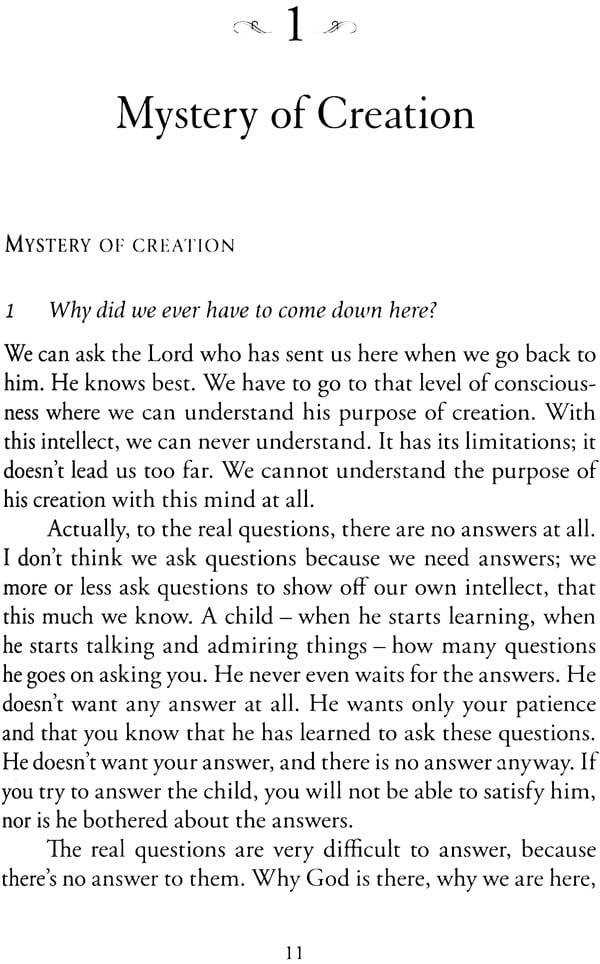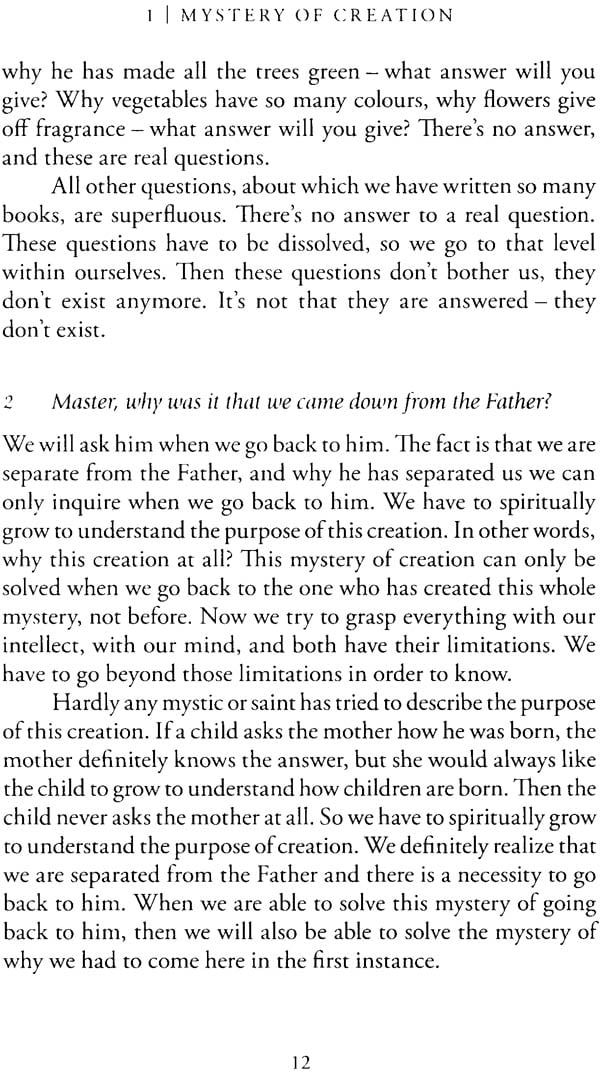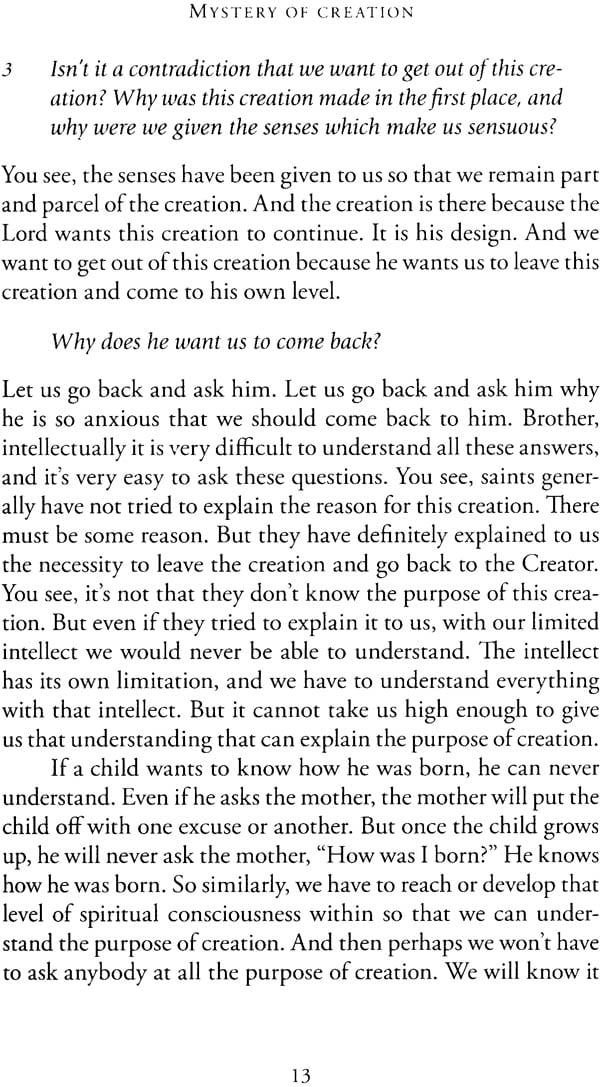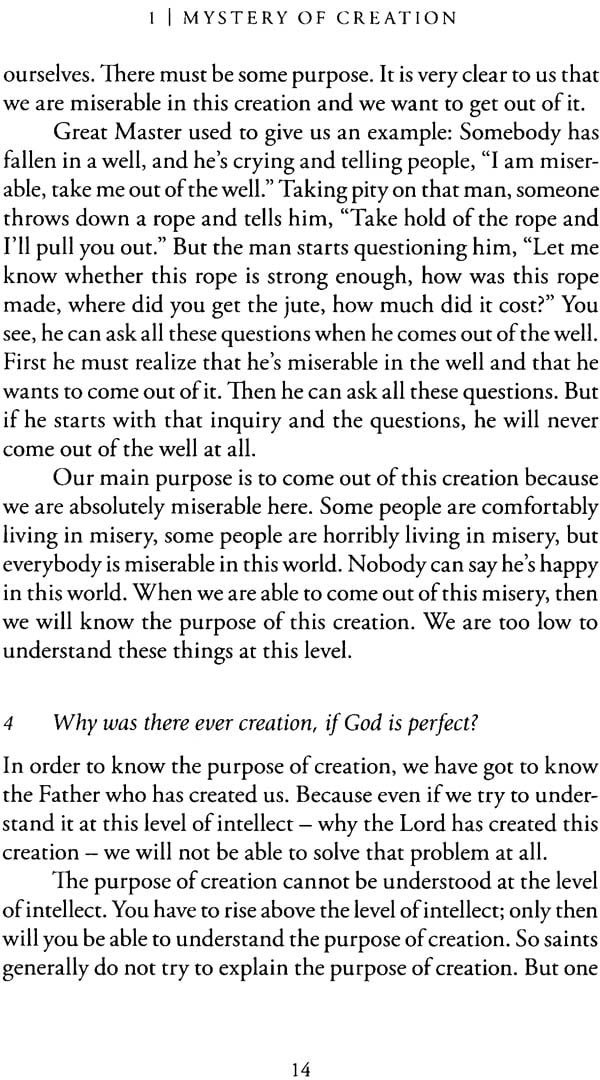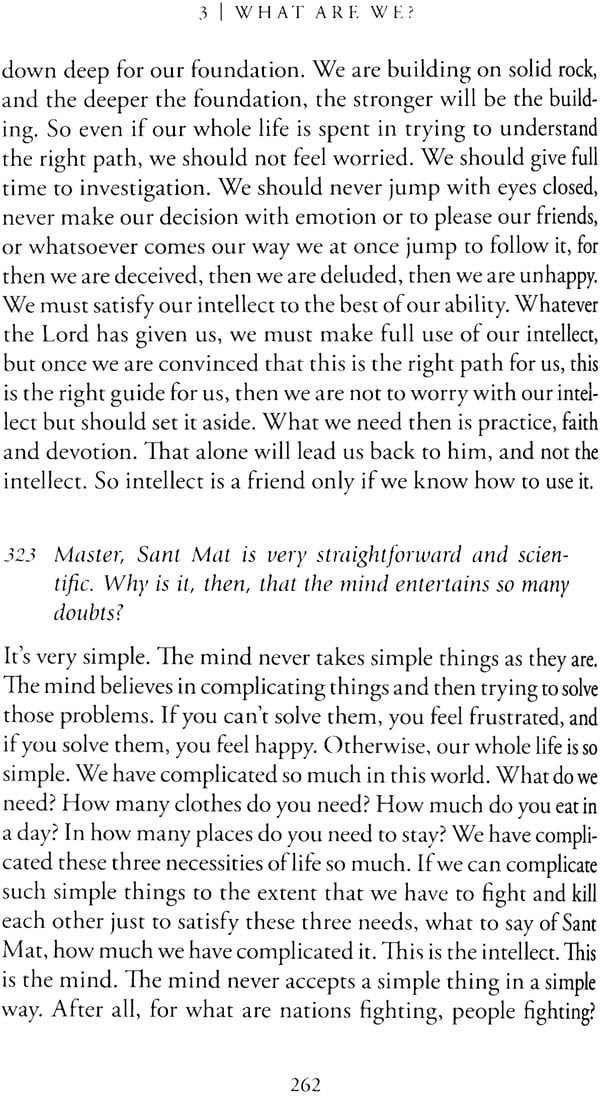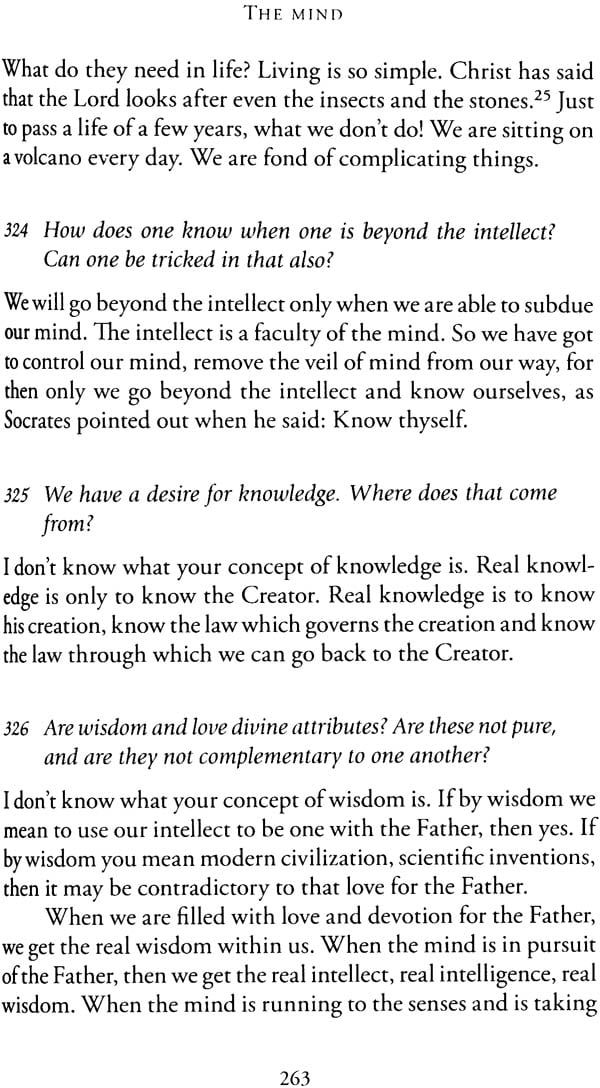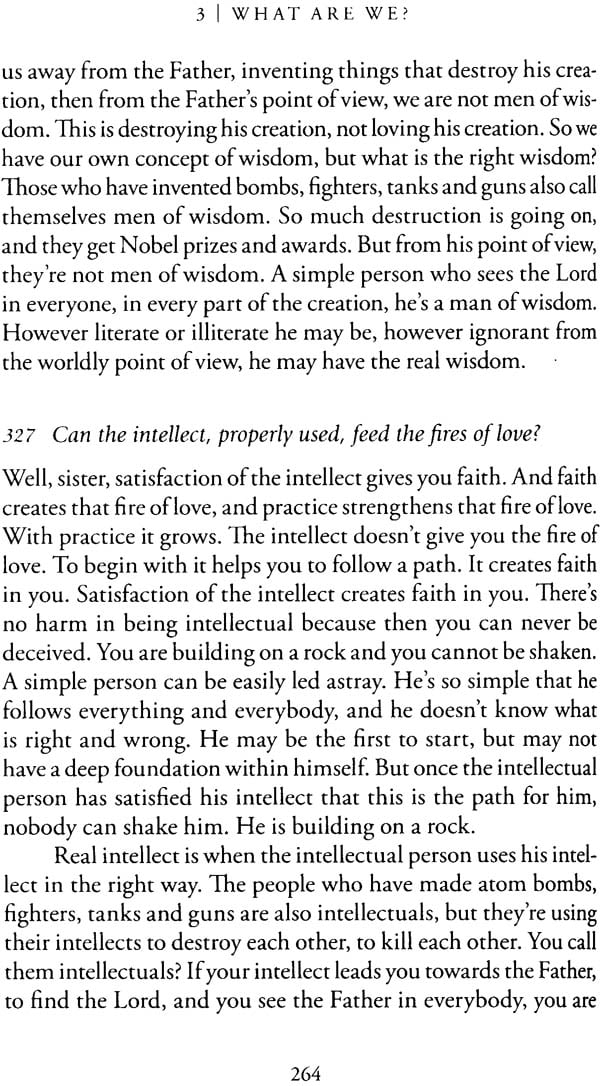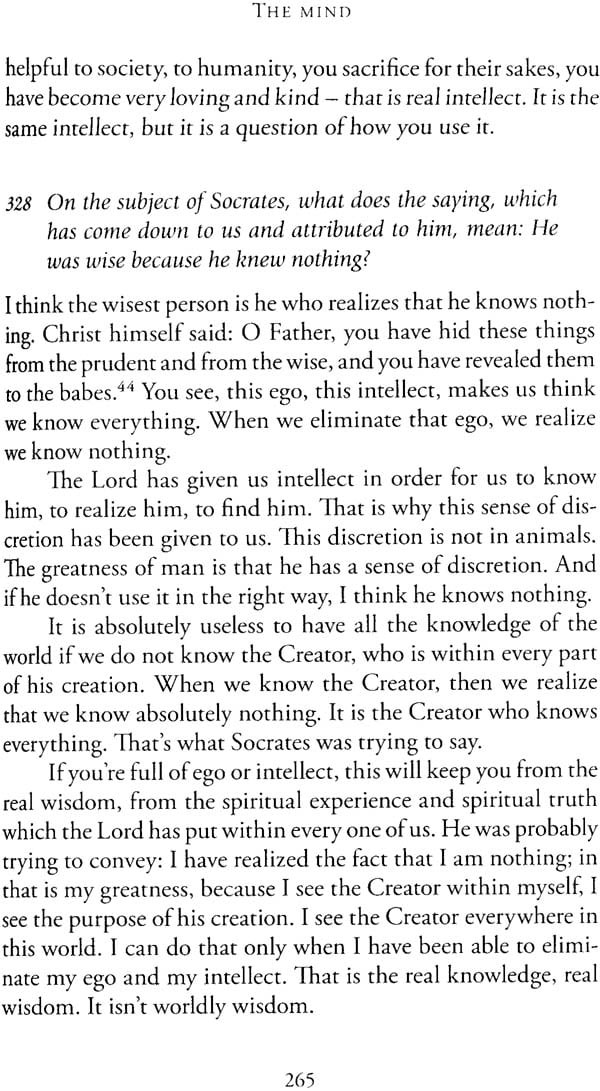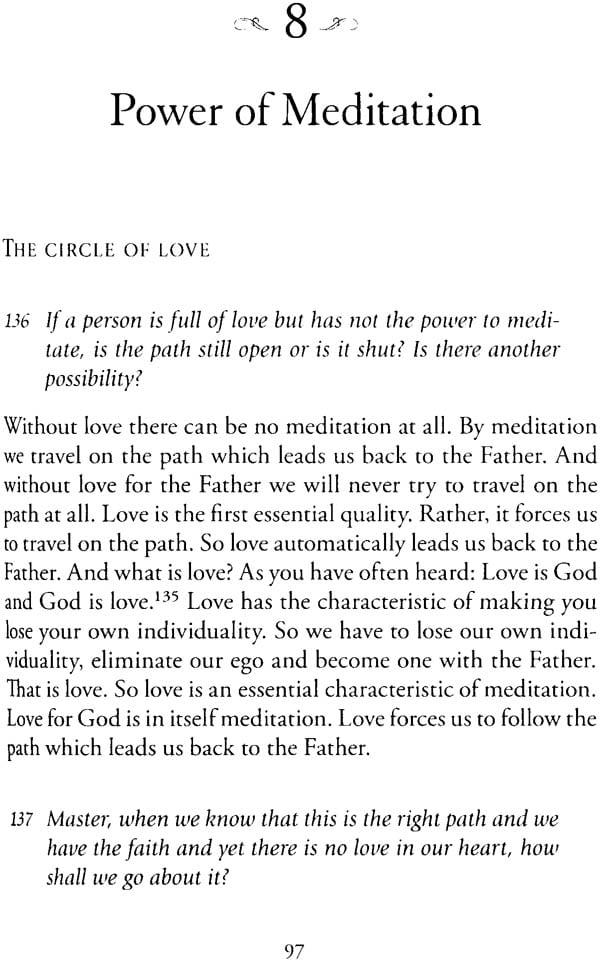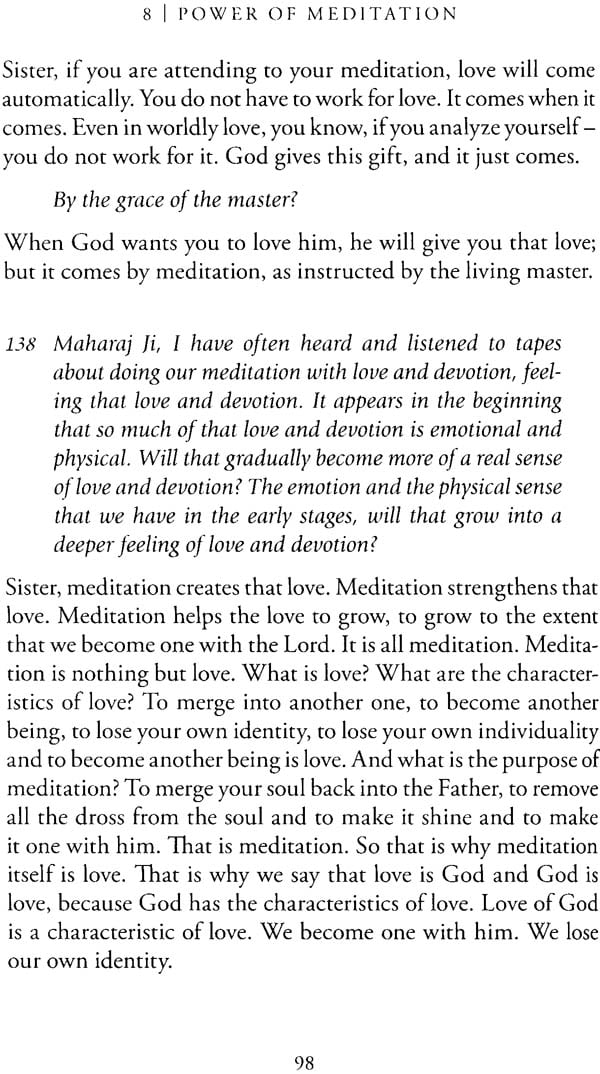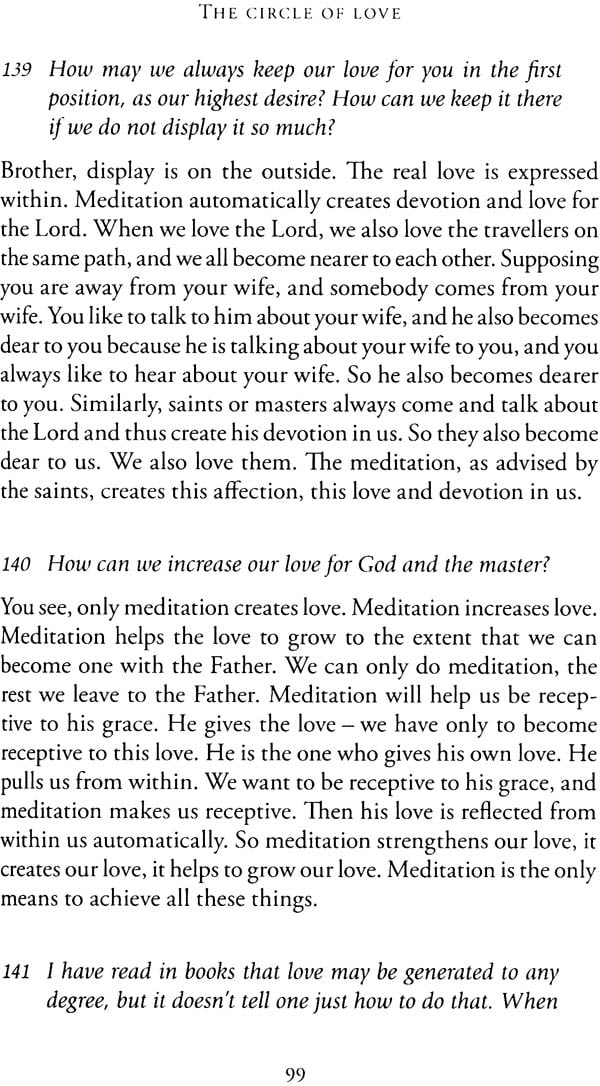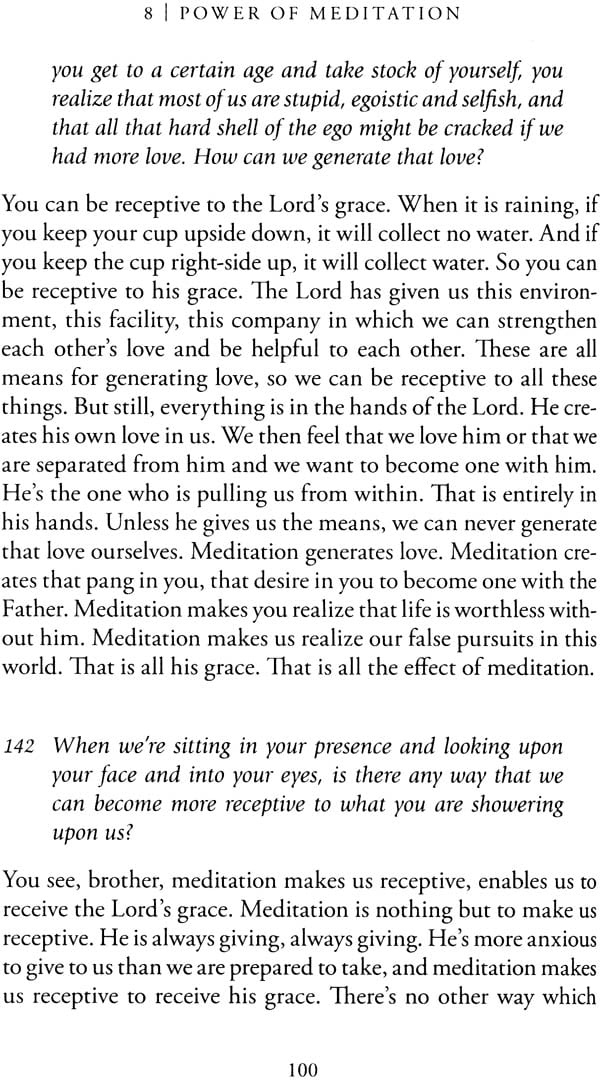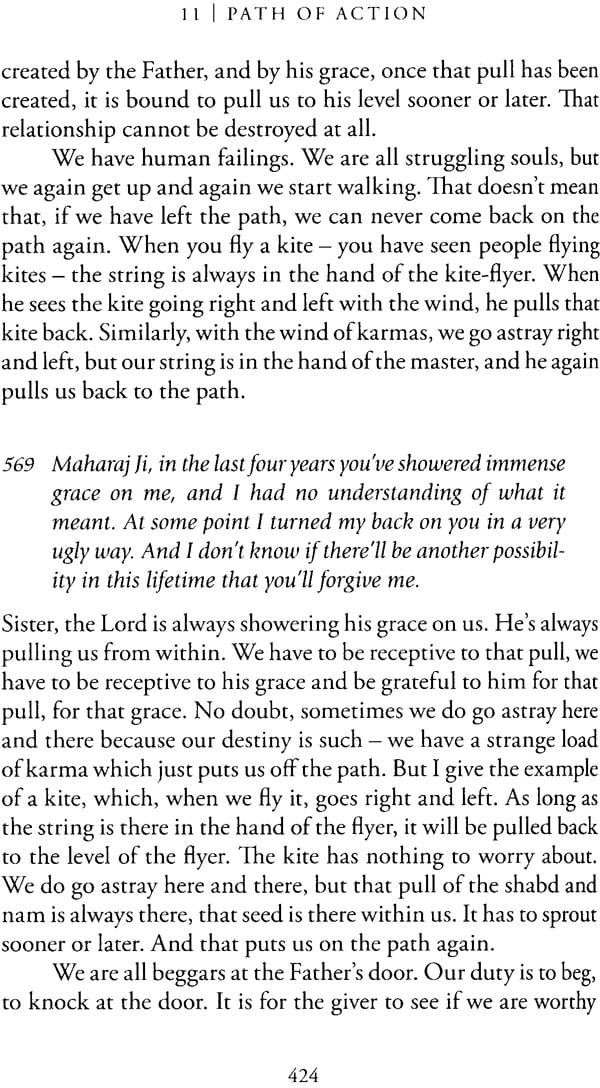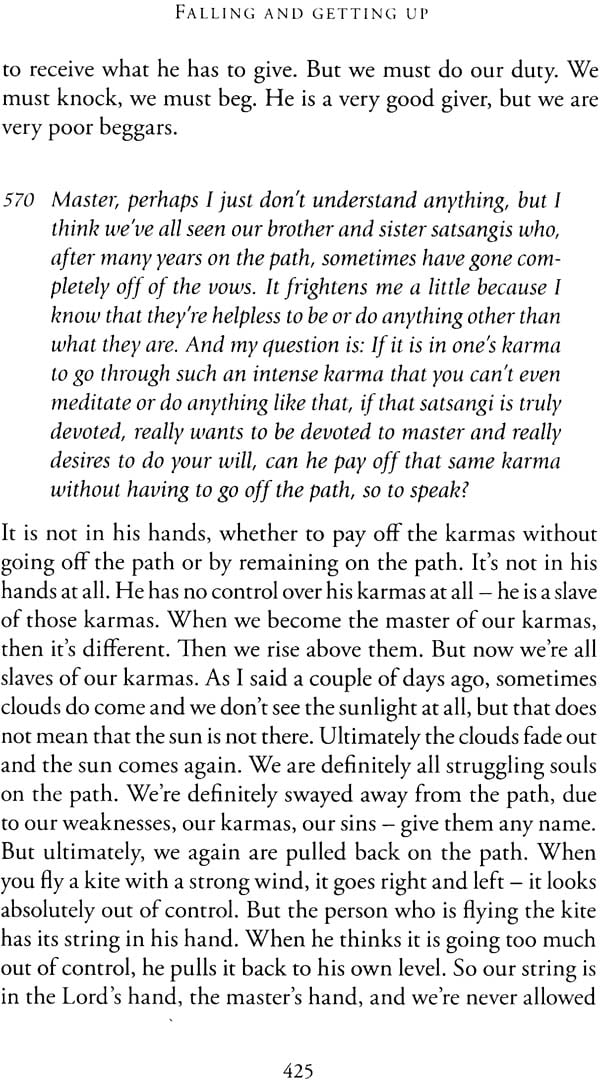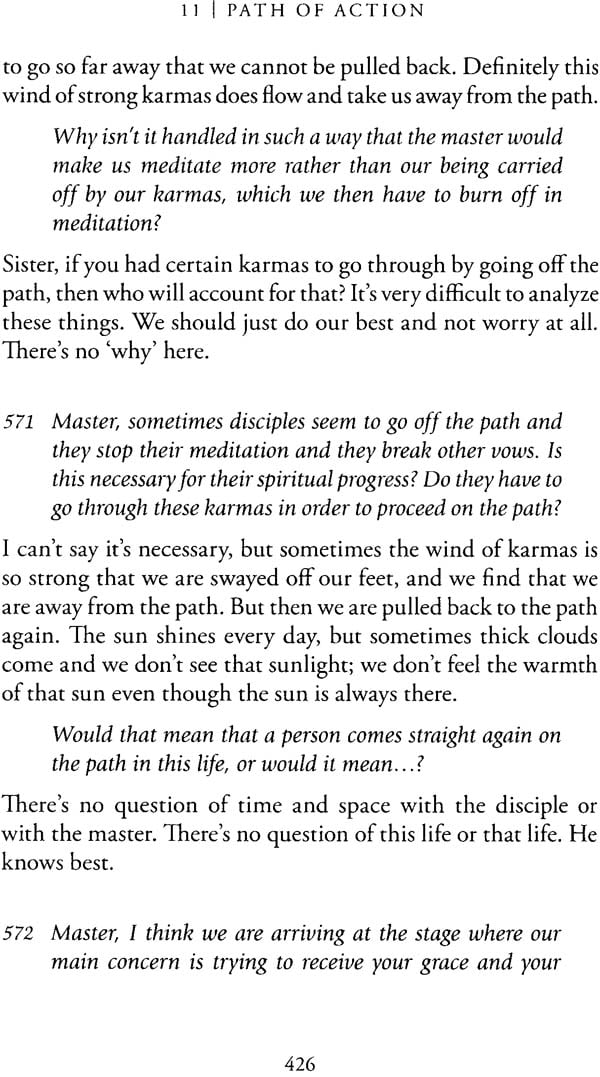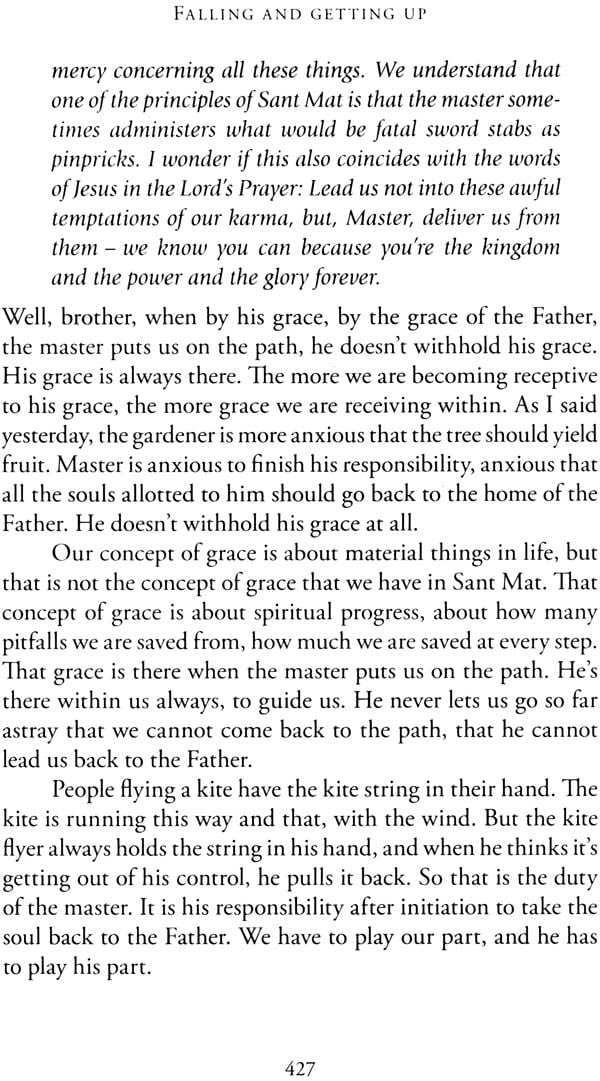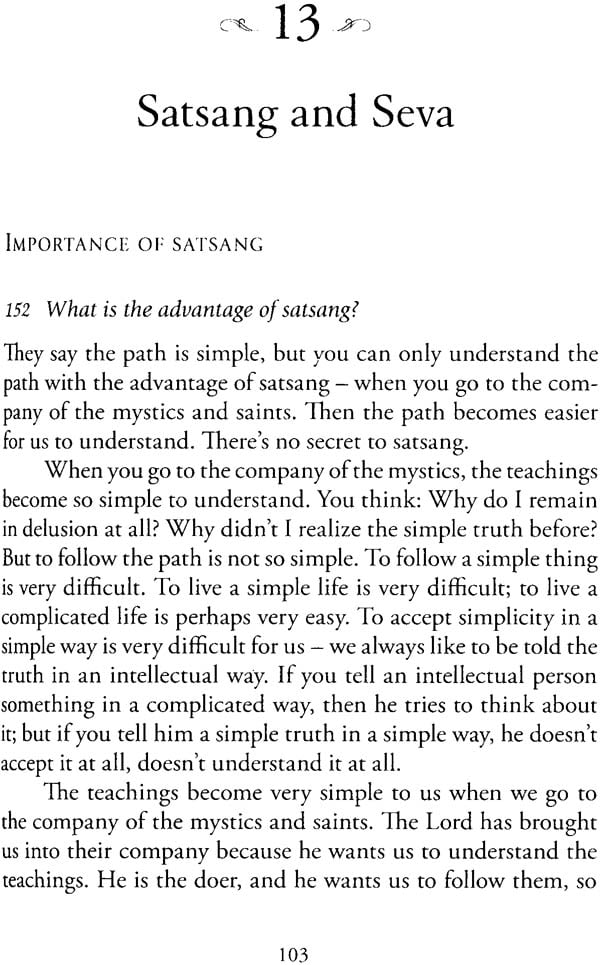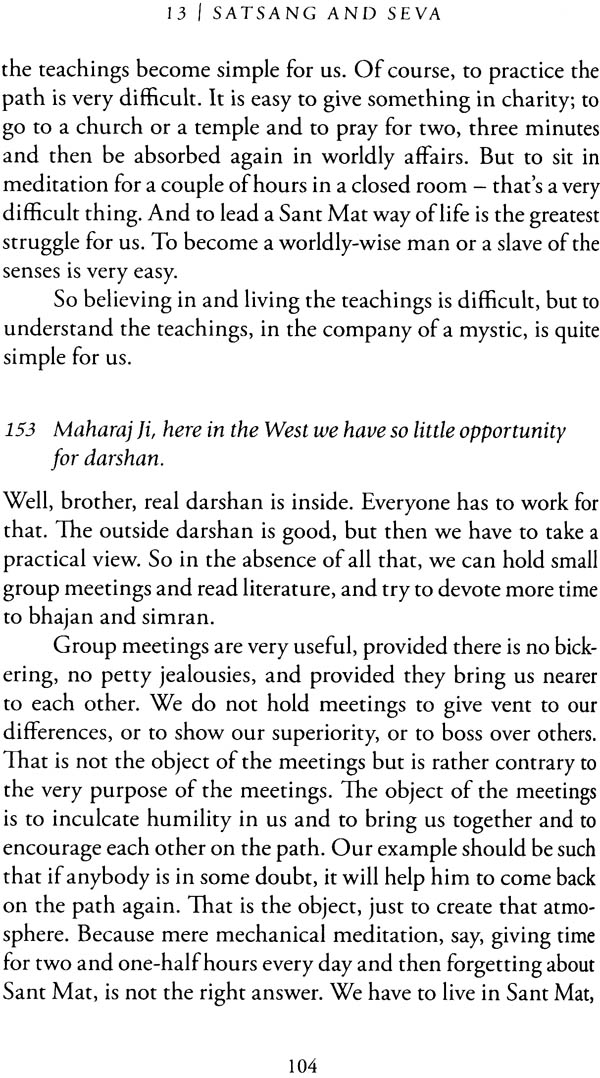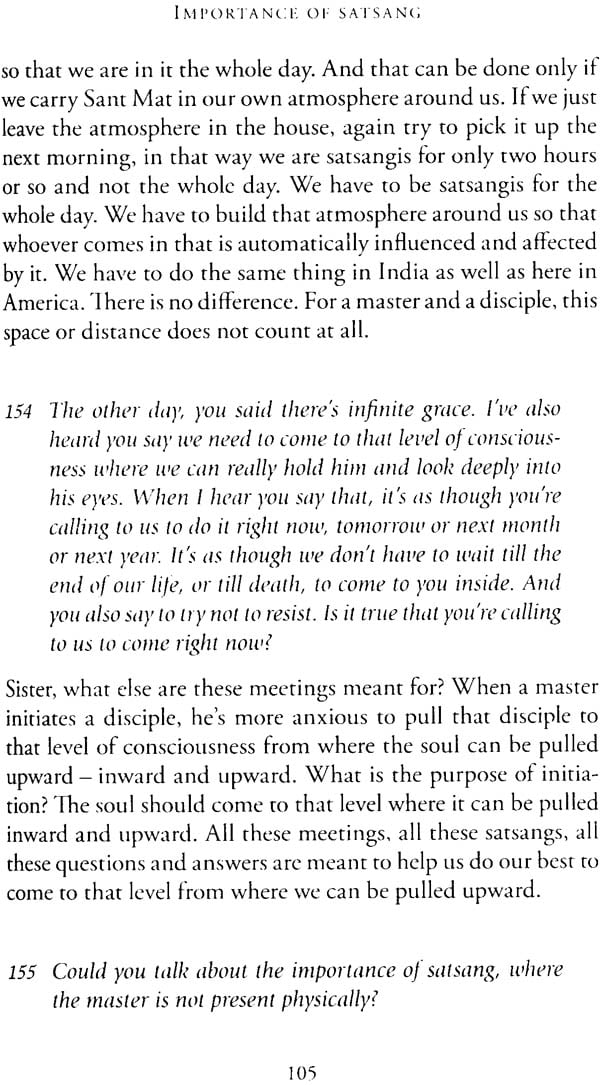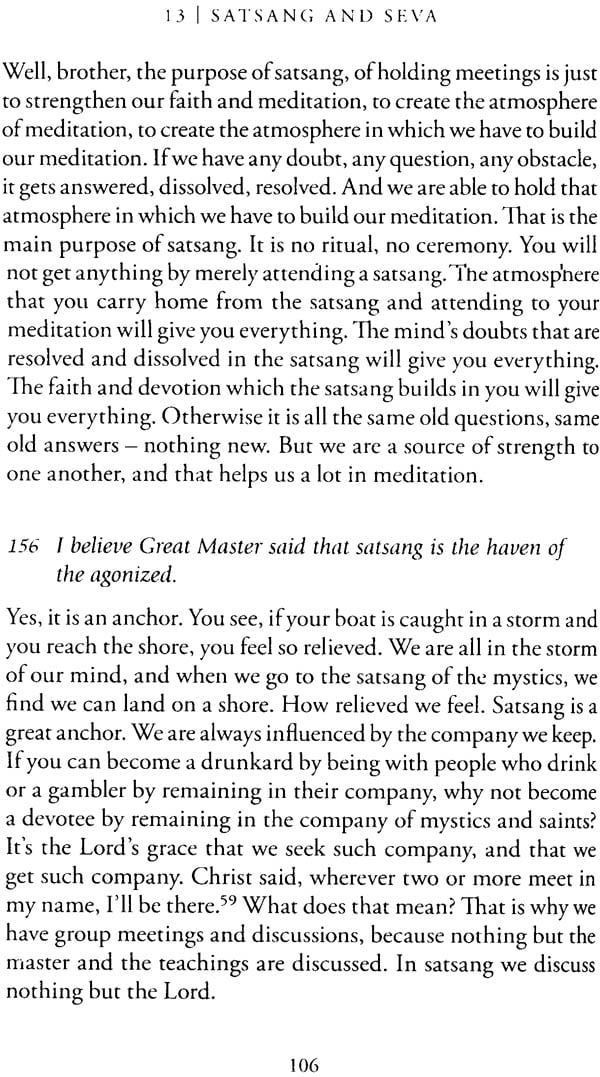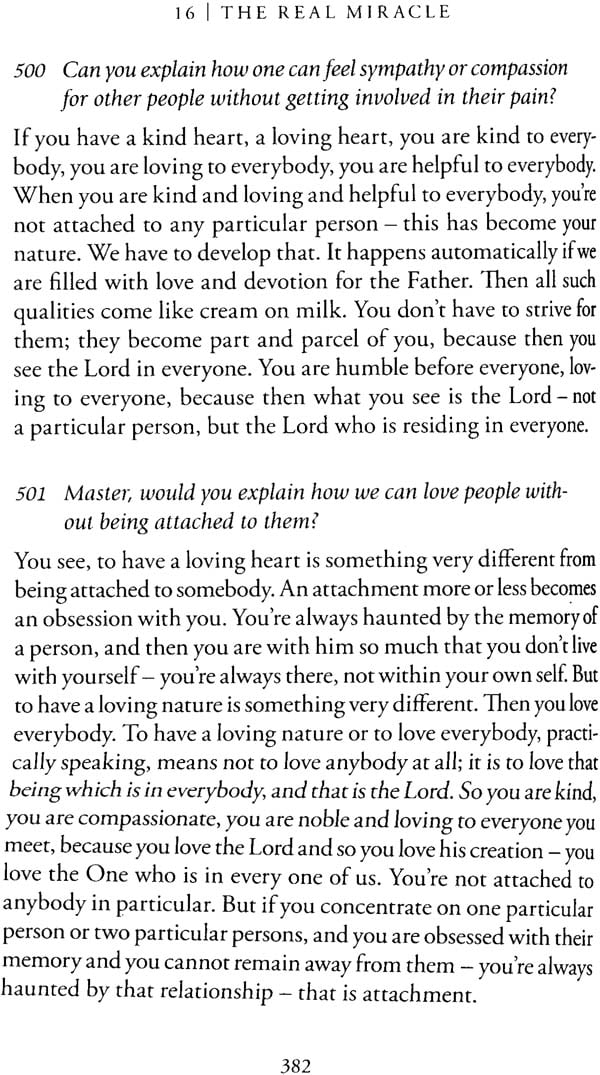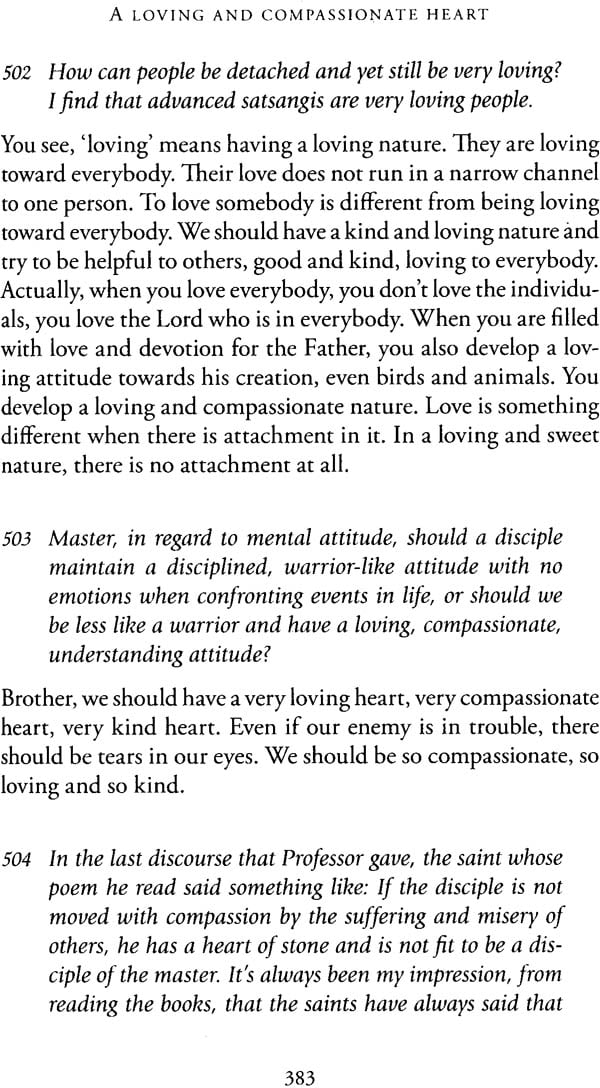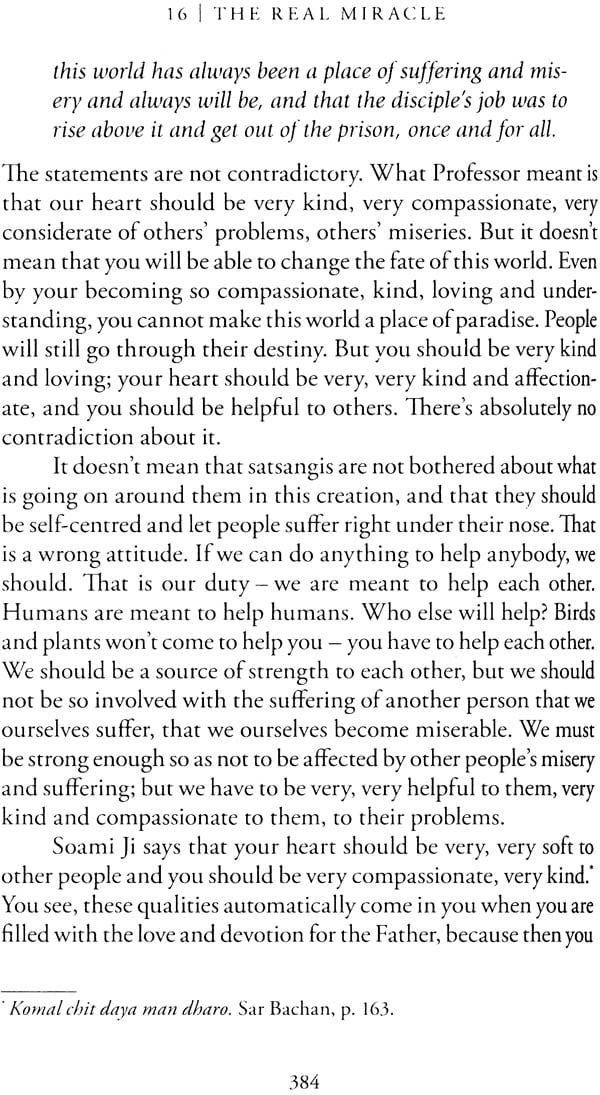
Spiritual Perspectives (In Three Volumes)
Book Specification
| Item Code: | NAC653 |
| Publisher: | Radha Soami Satsang Beas |
| Language: | English |
| Edition: | 2010 |
| ISBN: | Vol1:9788184662658 Vol2: 9788184662665 Vol3: 9788184662672 |
| Pages: | 1572 |
| Cover: | Hardcover |
| Other Details | 8.8 Inch X 5.8 Inch |
| Weight | 2.13 kg |
Book Description
The master lives among us to raise our consciousness to his own level. Both by example and precept, the spiritual master teaches us to withdraw our attention from material concerns of body and mind and awaken to the truth, power and beauty of the divine.
In olden times, a master would have a small number of disciples and communicate with them through personal interaction. His disciples would mostly be from the area where he lived, and his influence would reach them as he would travel to see them or they would travel to be in his company at his spiritual centre.
Since the early part of the twentieth century, the masters at Beas have attracted a growing number of disciples living in countries outside India. After Hazur Maharaj Charan Singh assumed the responsibilities of mastership in 1951, more and more overseas disciples began to seek his spiritual guidance. As increasingly they visited him in India, an International Guest House was created at Beas, and in 1961 he took the first of many tours to foreign lands to meet his disciples and seekers. At all these meetings, question-and-answer sessions in English were held at which the master would patiently respond to his disciples’ questions. Fortunately for us, heirs to his legacy, many of these meetings were tape-recorded.
This book contains a selection of those questions and answers drawn from almost thirty years of Hazur Maharaj Ji’s mastership, recorded between 1960 and 1990. In reading these exchanges, which have been organized according to subject, it is evident that the master used these sessions to create a bond of friendship, love and trust with us. The answers reveal that Maharaj Ji never acted as if he felt superior to us; he acted rather as one of us. He understood our problems and wanted to help us. But above and beyond, he did not create dependency; he taught us to think for ourselves and stand on our own feet. He wanted us to grow in confidence and understanding, and he guided us to come to our own conclusions.
Spiritual Perspectives offers an important foundation for people just embarking on the spiritual path, and serves as a comprehensive and practical guide for all disciples attempting to live according to the principles taught by the master. It is our great pleasure to present this three-volume collection of Maharaj Ji’s responses to our questions so that we may all benefit from his wisdom.
All mystics and saints have the same message to give, the same spiritual truth to share with us, but everybody has a different approach, depending on the audience they want to reach. Some mystics have a very mild approach and some mystics — unless they just shake you from the roots, you will not understand. But they all have the same message; there’s no difference in their message, there’s no difference in the spiritual experiences they want to share with us, or the spiritual path they want to show to us.
— MAHARAJ CHARAN SINGH
Understanding the intellectual approach of his overseas disciples, Hazur Maharaj Charan Singh began holding question- and-answer sessions from the early days of his mastership in the 1950s until the time of his passing in 1990. For those of us fortunate to meet with the master in these small, informal gatherings, or who have heard tape-recordings of them, these sessions were the highlight of our relationship with him. “Any questions, please?” “Any new questions?” Those familiar words evoke memories of uncharted evenings of self-revelation, as Hazur Maharaj Ji would take our minds beyond the boundaries of habitual thought and preconceived ideas, challenging us to live our lives with greater love and confidence, free of fear and self-imposed limitations.
Maharaj Ji used the evening meetings as a way of creating an intimate bond, a relationship of love and support, and a deep sense of friendship with his sangat from abroad. Everyone had the sense of being taken care of, on every level of their being. The words of the master became a cocoon of safety and a prism of beauty and light through which we could look at our lives, and our world, with fresh eyes. In his gentle, humble, yet regal manner, Hazur Maharaj Ji imbued every moment in his presence with a magnetic energy that immersed us in his love.
When people would step up to the microphone to ask a question, they would feel that they were the only ones in the room with the master; time would literally stand still as they interacted with him. Maharaj Ji would intently focus his attention on the questioner, and in his response he often touched on an unexpressed, perhaps unconscious aspect of the problem being presented. He once commented, “I’m trying to understand you, rather than the question.”
Why do we ask questions? Hazur Maharaj Ji would often say;
We have so many books written in detail that if you read these books and try to digest what is written in them, I wonder if there will be any questions left at all. The books are beautifully written from the Western point of view, from an intellectual point of view, from a creative mind’s point of view, and we can know the answers to most of the questions just by reading and studying them. In fact, we always know the answers, and only that answer appeals to us which we already know. Otherwise, the answer that we do not know will never appeal to us. I tell you, we always know the answer when we ask a question. It is in our subconscious. The answer is always there, but we only want a corroboration of that which we think is right, and we are happy when we find that it is right. That is all; otherwise all our books are full of answers.
No problem, no person, was too unimportant for Maharaj Ji. In his unstated humility, he treated everyone with complete respect. He saw beauty in us all, as if we were uncut diamonds; and he shone his brilliant light into us, to polish us so that we might manifest some of that beauty. To adapt a metaphor he often used, he created the hunger in us for spirituality, he prepared the food and served it, and then he helped us to eat it by pulling us to him and keeping us in his radiant presence.
Maharaj Ji indulged us tremendously in those question- and-answer sessions. No doubt many of the questions were just excuses to stand before the master and have his attention, but he welcomed it. He showered his affection on us like a father playing with his infant child, lifting him overhead with pleasure and hugging him gently. He reached down to us on our level, and brought us up to his.
Those evening meetings sometimes felt like a wonderful game, a courtship between lover and beloved. We wanted to keep him there for as long as possible, and he wanted to be with us. As he once said:
I am quite conscious that many people don’t have a question, even when they come to ask a question. And even if they do have questions, they are not interested in the answer, and they don’t want any answer. And whatever answer I may give them makes no difference to them. They only want to talk; they only want to keep me here; they only want to hear me. I am quite conscious of it.
When I find seekers, real seekers, I do give the answer, and with clarity. Sometimes I know their real purpose behind it, so I put it off in one way or another.
So this game is going on. And I know every day it will be the same. It’s not one session or two sessions, or one meeting or two meetings. For the past thirty-five years, this question-and-answer is going on. No dearth of books have been printed, no dearth of tapes recorded; same questions, same answers.... I don’t know what is the reason, but it is going on. They want to be here and I want to be with them; they want to be with me, and we are here. You can explain it in any way.
Hazur Maharaj Ji nurtured our capacity to understand Sant Mat as a practical spiritual path to guide and govern our daily life and actions. He covered a comprehensive range of topics during those lively meetings, which brought breadth and depth of understanding to the questioner and everyone in the audience, no matter how narrow the particular question.
Although everyone knew that the ultimate answer to every question was “meditation,” few could hold themselves back from taking the opportunity to engage him in dialogue.
Q: A lot of us, including myself want to ask you specific questions, and generally we get a response to do our meditation and have faith. Should we try to avoid asking these questions? Should we just concentrate on our simran?
M: Well, brother, you can ask me any number of questions, but I am sorry to say, I have only one answer You see, I don’t mind attending to your questions, but my answer will be the same in a nutshell. Whether you take it in a simple word or whether you take it in a more complicated word, or whether I explain it to you intellectually or in a simple way, there is no difference. The answer will be the same.
In responding to questions, Maharaj Ji often illustrated his answers with examples from mundane topics, such as the weather, agriculture and domestic life. As his overseas audience in those days was largely Christian, he would also quote the familiar parables and sayings of Christ, as well as tales and poetry of the Indian and Persian mystics. In illustrating the relationship of the soul with the Lord, he would sometimes use examples from domestic life, particularly the idealized love of the wife for the husband in the traditional Indian family. Thus he was able to reach audiences with diverse religious and social backgrounds and also to convey the universal truths at the heart of all religions and spiritual teachings.
These three volumes represent Maharaj Ji’s answers drawn from the entire period of his mastership: the hundreds of sessions he held at the International Guest House at Dera, his tours abroad, and the Delhi and Bombay sessions of the 1980s (when Punjab was closed to foreigners). Most of the questions and answers in the books The Master Answers and Thus Saith the Master appear here, interwoven with previously unpublished material.
Transcribed from original recordings, the questions and answers have been edited lightly to eliminate excessive repetition and correct the English syntax and usage. It was the master’s wish that his rough spoken material, when presented in print, be edited into a smooth and readable text. Continuing guidance on the process of editing has been provided by Hazur’s successor.
The editing of Spiritual Perspectives reflects contemporary English usage. Because these volumes are intended to nourish satsangis and seekers for many years to come, a lowercase approach has been taken — a radical departure from the older Sant Mat books, in which many terms were capitalized to indicate their spiritual sense. It was felt that this approach is no longer necessary, as the spiritual meaning is evident from the words themselves and the context in which they were spoken. Only terms designating the Lord himself and common epithets for God, the personalized supreme Father, have been capitalized.
In citing the teachings of Christ or the Indian saints, Maharaj Ji would sometimes quote the scriptures, but more often than not he would paraphrase the teachings of past saints and weave them into his responses. For the sake of simplicity, we have presented these references as paraphrases and have not enclosed them in quotation marks. The actual quotes appear as Endnotes at the back of each volume. They are arranged in the sequence as they appear in the Bible and are numbered accordingly. The superscript numbers in the text, therefore, follow the biblical sequence rather than the order in which they appear in the book.
The material presented in this three-volume collection has been organized into sixteen chapters, which mirror the spiritual journey of the disciple. Questions range from the practical issues of everyday life to cosmic principles such as karma and reincarnation, the role of the master, and the practice of meditation and its power to transform our lives. Accordingly, Volume I is titled “Understanding the Basics”; Volume II, which deals with meditation and the inner struggle, is called “Walking the Path.” Volume III, “Living the Life,” concerns the disciple’s relationship with the master, the support to be gained from satsang and seva, and living a balanced life in the world. The final chapter, “The Real Miracle,” presents responses that touch largely on the transformation that takes place in us as we follow the path to the best of our ability. The answers emphasize the positive attitude that will sustain us throughout our journey, and explore the spiritual qualities that rise to the surface naturally, like “cream on milk,” as Maharaj Ji used to say. The chapter culminates with a restatement of the miracle of the master’s grace that has brought us on the path.
While the book’s wealth of spiritual guidance has been arranged in topics and, taken as a whole, is an overview of Sant Mat, its essence is the personal, individual exchange. Each question and answer reveals the dynamic connection between a living master and his disciples. The book therefore may be read either as a sequence of topics or in random fashion, by taking a question and its answer from any part of the book and pondering on it as though we, too, were sitting in the presence of the master, reflecting on how his words relate to our own life and spiritual journey. Most of the time Maharaj Ji’s answers touched on several themes at once, inviting listeners to reflect on not only the particular subject under discussion, but other, related topics as well. So although the answers have been arranged in chapters according to their primary topic, a subject index has also been included to allow the reader to research a chosen theme throughout the entire collection.
The title Spiritual Perspectives aims to convey the sense that the master’s answers, taken as a whole, provide many perspectives of a subject, on various levels, thus offering a richness and depth that reach far beyond our own finite understanding. But even as we read, we see that the master’s words, whether spoken or written, only hint at the spiritual reality. The experience of spirituality is something entirely different, beyond human language. There has always been a tendency to confuse the words that the saints utter with their inner teaching, and compartmentalize and limit that deeper truth. We ossify the saints’ teachings by taking their words literally and arresting them in scriptures and doctrines. But scriptures can only hint at the reality the saint’s experience and want to share with us. At best, human language is merely a pointer to the truth. Only when we have expanded ourselves to the infinite, as the master has done, can we really understand the deeper meaning of his words.
This collection of the words of Hazur Maharaj Charan Singh, drawn from more than thirty years of his selfless ministry, is a testament to the miracle of the living master. Ever ready to meet us at our level, encouraging us to ask questions, and then — with affection yet firmness — answering us in the simplest and most down-to-earth manner, the master is always present for his disciples. His unbounded kindness, love and patience inspire us to do what is important in life so that we might rise up to meet him within.
At that level of consciousness, what questions will you ask? You’re not interested in the world; you’re not interested in this creation at all. You’re so much absorbed in your love and being with your beloved, what questions will you ask? You may have a list of a thousand questions in your hand, but you forget everything, and all your questions are dissolved. Love helps you to rise above all those questions. Definitely he answers all your questions, but you will hardly have any question to ask.
Volume I: Understanding the Basics
| Preface | xi | |
| Introduction | 1 | |
| 1. Mystery of Creation | ||
| Mystery of creation | 11 | |
| Gods as reality | 20 | |
| Creation as a projection of the Lord | 26 | |
| Continuation of the creation | 32 | |
| Creation as the Lord’s play | 37 | |
| Kal | 43 | |
| Good and evil | 51 | |
| 2. Shaping Our Destiny | ||
| Shaping our destiny | 63 | |
| Clearing karmas | 82 | |
| Duty and karma | 101 | |
| Transcending karma | 104 | |
| Sanskaras | 111 | |
| Sowing seeds of karma | 114 | |
| Destiny and free will | 126 | |
| Reincarnation | 151 | |
| 3. What Are We? | ||
| Relationship of the soul to God | 169 | |
| The Human form | 188 | |
| Self-realization and God-realization | 199 | |
| Relationship of the soul to the mind and senses | 210 | |
| The mind | 244 | |
| Ego | 266 | |
| Attachment and desires | 273 | |
| 4. The Soul Has No Religion | ||
| Give him any name | 283 | |
| The soul has no religion | 286 | |
| Arresting the teachings | 299 | |
| One path, many religions | 318 | |
| Scriptures and holy books | 327 | |
| How the saints teach | 335 | |
| 5. Lost and Found | ||
| Lost in a maze | 343 | |
| Suffering and loneliness as grace | 359 | |
| Happiness | 363 | |
| Improving the world | 378 | |
| Peace | 386 | |
| Market souls | 402 | |
| Grace to be pulled | 427 | |
| Association with a master | 434 | |
| 6. Role of the Master | ||
| What is a master? | 441 | |
| All masters are one | 449 | |
| Need for a living master | 461 | |
| Purpose of the master | 483 | |
| The masters’ miracles | 501 | |
| Masters are above karma | 507 | |
| One flame lighting another | 513 | |
| Index to Bible Quotes | 519 | |
| Subject Index | 535 | |
| Addresses for Information and Books | 561 | |
| Books on This Science | 567 |
| 7. A Personal Commitment | ||
| Being pulled to the path | 3 | |
| Initiation | 12 | |
| Satisfying the intellect | 31 | |
| The four vows | 52 | |
| The vegetarian diet | 56 | |
| Giving up drugs and alcohol | 78 | |
| Ethics and morality | 84 | |
| 8. Power of Meditation | ||
| The circle of love | 97 | |
| The power of meditation | 104 | |
| Meditation and faith | 122 | |
| Meditation as true prayer | 129 | |
| 9. Practice of Meditation | ||
| The practice of meditation | 151 | |
| Come to the eye centre | 158 | |
| Simran, dhyan and bhajan | 171 | |
| Inner regions | 211 | |
| The radiant form | 230 | |
| Experiencing the shabd | 239 | |
| Dying while living | 243 | |
| Digest it within | 250 | |
| Progress | 258 | |
| 10. Effort and Grace | ||
| Regularity and punctuality | 277 | |
| Controlling the mind | 292 | |
| Practical questions | 303 | |
| Overcoming obstacles | 322 | |
| Effort and grace | 333 | |
| Responding to the inner pull | 362 | |
| 11. Path of Action | ||
| Living in the atmosphere of meditation | 377 | |
| Doing simran all day | 386 | |
| Living the principles | 392 | |
| A constant struggle with the mind | 396 | |
| Remaining in his discipline | 410 | |
| Overcoming weaknesses | 413 | |
| Falling and getting up | 420 | |
| Being a friend | 434 | |
| Making devotion our priority | 438 | |
| Loving not calculating | 447 | |
| Do it now! | 452 | |
| Appendix | 455 | |
| Index to Bible Quotes | 459 | |
| Subject Index | 475 | |
| Addresses for Information and Books | 501 | |
| Books on this Science | 507 |
| 12. Master and Disciple | ||
| Relationship of master and disciple | 3 | |
| Shabd is the real master | 32 | |
| Finding the master within | 40 | |
| Darshan | 47 | |
| Separation and longing | 60 | |
| Running after the master | 78 | |
| Parshad | 80 | |
| Awareness of his presence | 86 | |
| Passing of the master | 97 | |
| 13. Satsang and Seva | ||
| Importance of satsang | 103 | |
| Atmosphere of satsang | 120 | |
| What is seva? | 143 | |
| Types of seva | 150 | |
| Charity and desire less action | 154 | |
| 14. A Balanced Life | ||
| A balanced life | 159 | |
| Making decisions | 188 | |
| Worry | 194 | |
| Swim along with the waves | 198 | |
| Surrender | 214 | |
| Living in the Lord’s will | 222 | |
| Becoming humble | 231 | |
| Criticism and anger | 242 | |
| Forgiveness | 255 | |
| A peaceful and relaxed life | 267 | |
| 15. Facing Life and Death | ||
| Attachment and duty | 279 | |
| Marriage and family life | 309 | |
| Children | 320 | |
| Animals | 330 | |
| Physical and mental health | 333 | |
| Suicide | 348 | |
| Facing illness and death | 350 | |
| 16. The Real Miracle | ||
| A positive approach | 367 | |
| A fresh perspective | 374 | |
| A loving and compassionate heart | 379 | |
| Love is a gift from the Lord | 385 | |
| A grateful heart | 399 | |
| A miracle at every step | 402 | |
| True and eternal happiness | 409 | |
| Epilogue | 415 | |
| Index to Bible Quotes | 421 | |
| Subject Index | 437 | |
| Addresses for Information and Books | 463 | |
| Books on this Science | 469 |
